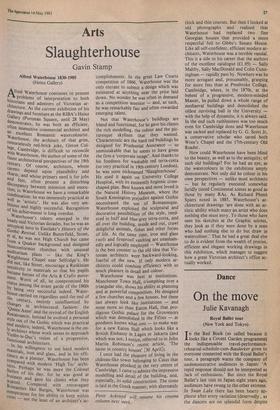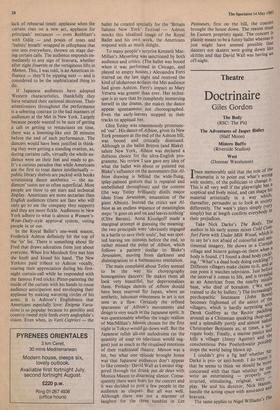Dance
On the move
Julie Kavanagh
In the Red Book (so called because it looks like a Covent Garden programme) the indispensable travel-performance- rehearsal-schedule-cum-Baedecker given to everyone connected with the Royal Ballet's tour, a paragraph warns the company of undemonstrative audiences in Japan: 'A tepid response should not be interpreted as lack of enthusiasm.' But since the Royal Ballet's last visit to Japan eight years ago, audiences have swung to the other extreme. In Swan Lake there has been hearty ap- plause after every variation (deservedly , as the dancers are on splendid form despite lack of rehearsal time): applause when the curtain rises on a new act, applause for principals' entrances — even Rothbart's with Odile — and posies of roses and 'babies' breath' wrapped in cellophane that one sees everywhere, thrown on stage dur- ing curtain calls. The audience responds im- mediately to any sign of bravura, whether after eight fouettes or the vertiginous lifts in Manon. This, I was told, is an American in- fluence — they'll be yipping next — and is considered to be the sophisticated thing to do.
If Japanese audiences have adopted Western characteristics, thankfully they have retained their national decorum. Their attentiveness throughout the performance is a sobering contrast to the bad manners of audiences at the Met in New York. Largely because people wanted to be sure of getting a cab or getting to restaurants on time, there was a lemming-like exit 20 minutes before the end of each performance. The dancers would have been justified in think- ing they were getting a standing ovation, as, during curtains calls, virtually the whole au- dience were on their feet and ready to go. It's a curious paradox that while Americans are the first to treat dance intellectually — public library shelves are packed with books scrutinising dance aesthetics — the au- diences' tastes are so often superficial. Most people are there to see stars and technical display. Americans are more sectarian than English audiences (there are fans who will only go to see the company they support) and they are more fickle. Audiences in New York adhere to what is almost a Women's- Wear-Daily-style approval system, voting people in or out.
In the Royal Ballet's one-week season, Frederick Ashton definitely hit the top of the 'in' list. There is something about Sir Fred that draws adoration from just about everyone. When Iris Murdoch first met him she knelt and kissed his hand. The New Yorkers paid tribute to Ashton vocally, roaring their appreciation during his first- night curtain-call while he responded with the famous Fred tricks: Pitter-pattering the inside of the curtain with his hands to rouse audience anticipation and enveloping their applause by making wavering circles of his arms. It is Ashton's Englishness that Americans especially love: Enigma Varia- tions is so popular because its gentility and country-tweed style feeds every anglophile's vision. Even when, in Varii Capricci — the
ballet he created specially for the 'Britain Salutes New York' Festival — Ashton mocks this idealised image of the Royal Ballet and his own work, the Americans respond with as much delight.
To many people's surprise Kenneth Mac- Millan's Mayerling was sanctioned by both audience and critics. (The ballet was booed when it was performed in Chicago, and played to empty houses.) Alessandra Ferri starred on the last night and received the kind of idolatrous acclaim the Met audience had given Ashton. Fern's impact as Mary Vetsera was greater than ever. Her techni- que is so sure that by completely immersing herself in the drama, she makes the dance appear spontaneous not choreographed. Even the early-leavers stopped in their tracks to applaud her.
Glen Tetley was unanimously pronounc- ed 'out'. His dance of Albion, given its New York premiere at the end of the Ashton bill, was booed and critically dismissed. Although in the ballet Britten (and Blake) salute New York, Albion was declared a dubious choice for the ultra-English pro- gramme. No review I saw gave any idea of what the ballet was about or pointed out Blake's influence on the movements (his Al- bion drawing is behind the wide-flung, splay-palmed gesture that is repeated and embellished throughout) and the content (the way Tetley brilliantly distils major ideas from Jerusalem, emanation of the giant Albion). Instead the critics saw Al- bion as an endless sequence of meaningless steps: 'it goes on and on and leaves nothing' (CliVe Barnes). Anna Kisselgoff made a marginal attempt at guessing the meaning: the two principals were 'obviously engaged in a battle to save their souls', but was spot- ted leaving ten minutes before the end, so rather missed the point of Albion, which follows a pattern similar to Blake's Jerusalem, moving from darkness and disintegration to a harmonious resolution.
The main complaint about Tetley seemed to be the way his choreography homogenises dancers: He makes them all look very beautiful, but depersonalises them, Perhaps dances of Albion should have been reserved for Japan, where an aesthetic, inhuman remoteness in art is not seen as a flaw. Certainly the refined sparseness of Albion's movements and design is very much in the Japanese spirit. It was questionable whether the tragic realism of MacMillan's Manon chosen for the first night in Tokyo would go down well. But the Japanese relish all-out melodrama (as the quantity of soap on television would sug- gest) just as much as the ritualised emotions of their traditional theatre. Manon was a hit, but what one episode brought home was that Japanese audiences don't appear to like comedy: David Wall as Lescaut stag- gered through the drunk pas de deux with Monica Mason to disarming silence. Conse- quently there were fears for the concert and it was decided to post a few people in the audience as claques. But all was well. Although there was not a murmer of laughter for the three tumbles in Les Patineurs, first on the bill, the concert brought the house down. The reason must be Eastern propriety again. The concert is plainly meant to be a funny ballet whereas it just might have seemed possible that dancers not skaters were going down like skittles and that David Wall was having an off-night.











































 Previous page
Previous page